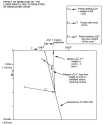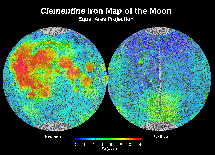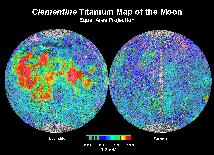NEEP533 Course Notes (Spring 1999)
Resources from Space
Lecture #11: What does the Moon tell us about our future?
Title: Evolution of the Moon: The Apollo Model, continued
Visuals
Slides illustrating the phases of lunar evolution
Notes
REVIEW
Light Colored Plains: Lunar wide, light-colored debris deposits in closed basins, whose deposition appears to post-date near-by large basins, may have several origins, including (1) gas-charged, fluidized impact debris flowing over the surface and settling in low areas much like a fluid and )2) gas-charged, fluidized precursors to eruptions of mare basalt by which the volatile-rich, earliest partial melt has entrained light-colored, fine-grained crustal debris. Evolved hydrogen from the lower mantle may be the principle gas component (See Stage Two, above).
Stage Six: The Basaltic Maria - 3.8-3.0(?) eons. Mare basalts (see Basaltic Volcanism, 1981), including pyroclastic debris from fire fountains that appear late in each basins history, erupted at the lunar surface and intruded the subsurface. These basalts appear to have uniformly had temperatures in excess of 1200o C and extremely low viscosities (<30p), resulting in flows as much as 1200km long.- There also is evidence in Apollo breccia samples of high-Al, low -Ti basalt eruptions as early as 4.0 by (Wilhelms, 1987) or 4.2 by (Heiken, et al , 1991) and evidence of eruptions as late as 1 by (Spudis, 1996) using crater counting techniques. The high aluminum content of the pre-3.8 by old basalts may be the consequence of individual eruptions of relatively small volumes of magma that assimilated (desolved) significant amounts of the plagioclase-rich debris encountered on the way to the surface. This contamination with crustal debris would not be as noticeable in later, extremely high volume eruptions.
Note: The Earth continues to evolve toward compositional, thermal, and gravitational equilibrium due to convection, melting, and differentiation (Bowring and Housh, 1995, Monastersky, 1997). The influence of such processes on the Moon was much more limited and largely concluded with the end of the Basaltic Maria period, about 3.0 by ago, although there is some evidence of continuing local mare basalt eruptions in the Procellarum and Crisium regions.
 Major Lunar Features: End of the Basaltic Maria Stage
Major Lunar Features: End of the Basaltic Maria Stage
 Full Moon (nearside) albedo variations
Full Moon (nearside) albedo variations
 Map of Nearside Maria (Wilhelms, 1987) [250 kB]
Map of Nearside Maria (Wilhelms, 1987) [250 kB]
 Mare Imbrium surface structures at sunrise from 60 nm.
Mare Imbrium surface structures at sunrise from 60 nm.
 Taurus-Littrow Mare from 60 nm.
Taurus-Littrow Mare from 60 nm.
 Boulder field around Camelot crater at Taurus-Littrow.
Boulder field around Camelot crater at Taurus-Littrow.
 Mare basalt boulder in situ at Taurus-Littrow.
Mare basalt boulder in situ at Taurus-Littrow.
 Vesicular basalt from Taurus-Littrow.
Vesicular basalt from Taurus-Littrow.
 Non vesicular basalt from Taurus-Littrow.
Non vesicular basalt from Taurus-Littrow.
 Orange soil deposit in rim Shorty crater.
Orange soil deposit in rim Shorty crater.
 Shorty Crater, about 80m in diameter.
Shorty Crater, about 80m in diameter.
 Area of orange soil deposits in the Sulpicious Galles region
on the southern rim of Serenitatis.
Area of orange soil deposits in the Sulpicious Galles region
on the southern rim of Serenitatis.
SUMMARY
LUNAR MARE BASALTS- GENERAL CHARACTERISTICS
- QUANTITY
- 17% OF SURFACE AREA
- 1% OF MASS OF CRUST
- 17% OF SURFACE AREA
- AGES
- SAMPLED FLOWS GENERALLY 3.8 TO 3.2 BY
- SOME FRAGMENTS INDICATE AGES AS OLD AS 4.1
- CRATER COUNTING INDICATES AGES AS YOUNG AS 1.0 BY
- SOME FRAGMENTS INDICATE AGES AS OLD AS 4.1
- VISCOSITY VERY LOW
- 10X LESS THAN THAT OF AVERAGE TERRESTRIAL BASALT
- SOME FLOWS MAPPED FOR AT LEAST 1000 KM
- EFFECT OF REDUCED GRAVITY AND LOW VISCOSITY = ABOUT 50% FASTER TRAVEL
- SOME FLOWS MAPPED FOR AT LEAST 1000 KM
- COMPOSITIONS
- CONSISTENT WITHIN A FLOW
- HIGHLY VARIABLE FROM FLOW TO FLOW IN SAME AREA AND ACROSS THE MOON
- TITANIUM
- IRON
- ALUMINUM
- POTASSIUM
- IRON
- HIGHLY VARIABLE FROM FLOW TO FLOW IN SAME AREA AND ACROSS THE MOON
- RARE EARTH ELEMENT PATTERNS
- Eu DEPLETION INDICATES SOURCE FROM WHICH FELDSPAR AND/OR Ca-PYROXENE
HAVE BEEN EXTRACTED
- PATTERNS AS FUNCTION OF AGE INDICATE THAT SOURCE REGIONS BECAME DEEPER WITH TIME
- LOTS OF SMOOTH WALL HOLES (VESICULES)
- INDICATE AN IMMISCIBLE GAS PHASE IN LAVAS
- APOLLO 11 ANALYSIS DEMONSTRATED THAT EACH SAMPLE HAD A DISTINCT SET OF PHASES LINING THE WALLS
- COMBINATIONS OF PLAGIOCLASE, ILMENTITE AND PYROXENE LUNAR MARE BASALTS
- APOLLO 11 ANALYSIS DEMONSTRATED THAT EACH SAMPLE HAD A DISTINCT SET OF PHASES LINING THE WALLS
- DIFFERENTIATION PATTERNS
- FEW LARGE CRYSTALS (PHENOCRYSTS)
- THERMAL HISTORIES DIFFERENT FROM TERRESTRIAL BASALTS
- MAGMAS SPENT LITTLE TIME IN LARGE CHAMBERS
- MAGMAS TRAVELED RAPIDLY FROM SOURCE
- MAGMAS SPENT LITTLE TIME IN LARGE CHAMBERS
- SIGNIFICANT GRAVITY DIFFERENTIATION IN INDIVIDUAL FLOWS
- OLIVINE (SINK)
- ILMENITE (SINK)
- PLAGIOCLASE (FLOAT)
- VESICULES (FLOAT)
- PLAGIOCLASE
- PLAGIOCLASE/PYROXENE
- PYROXENE
- ILMENITE (?)
- PLAGIOCLASE/PYROXENE
- ILMENITE (SINK)
- THERMAL HISTORIES DIFFERENT FROM TERRESTRIAL BASALTS
- DEPTH OF PARTIAL MELTING
- 200-400 KM (10-20 KB)
- OLIVINE AND ONE OR TWO PYROXENES ON LIQUIDUS
- GENERAL CHARACTERISTICS
Major Issue: Why did relatively little basaltic maria erupt in the very deep, old basins of the farside?- Equivalent gravitational potential surfaces still lie beneath or close to the bottom of these basins due to ~2km displacement of the center of mass from the center of figure?
- Regional chemical and radioisotopic heterogeneities in the lunar mantle were extreme enough to preclude the generation of significant volumes of mare basalt? (Spudis, et al., 1994, in Nozette, et al., 1994)
- Thicker crust on the farside inhibited large volume eruptions as that crust would counter the pressure built up by a volume change from rock to liquid (Yingst, R.A., and Head, J.W., 1995, as reported in Science News, v 148, 324).
- Does not explain relative absence of maria in farside basins that overlie thin crust (Zuber, M.T., 1995, as reported in Science News, v 148, 324).
- Old large basin forming events on the farside, such as South Pole-
Aitken removed most of the insulating layer formed during the Cratered
Highlands Stage (Lecture 10), preventing the accumulation of sufficient
heat to melt large volumes of the mantle.
- A graphical summary of pressure/temperature relationships related to
the creation and eruption of mare basalts is given below:
- A graphical summary of pressure/temperature relationships related to
the creation and eruption of mare basalts is given below:

- In the above figure, the following implications should be noted:
Path #1 would be the path followed if crustal insulation was sufficient to allow remelting of the mantle to occur and the overlying lithostatic pressure was low enough to permit upward movement to the surface. A clear set of examples are the visible mare filled basins. It is possible that in some cases, the formation of the basin removed sufficient crustal mass to trigger the eruption of already formed magma. This possibility is suggested by the closeness of the ages of the basin forming event and the oldest known mare basalt fill. The Serenetatis Basin, with an impact age of 3.88 +/- 0.08 by and an oldest basalt age of 3.70 +/- 0.10, is the only possible example known where this may have happened on the Moon (it has been proposed to explain large masses of basaltic composition rocks that are or might be associated with large impact events on Earth, e.g., Sudbury and Bushfeld).
Path #2 would be the path followed if crustal insulation was insufficient for mantle temperatures to reach partial melting levels. This may have been the case beneath the South Pole-Aiken Basin on the far side of the Moon (see South Pole-Aiken discussion under Stage Four in lecture 10). Path #3 would be the path followed if total thickness (pressure) was too great to permit movement of magma to the surface. This most likely was the case under most of the southern and far side highlands. SUMMARY - LUNAR PYROCLASTICS
- (VOLCANIC GLASSES AND DEVITRIFIED VOLCANIC GLASSES)
- GENERAL CHARACTERISTICS
- TYPES (ALL PRODUCTS OF EXPLOSIVE VOLCANISM)
- REGIONAL
- ASSOCIATED WITH LARGE BASIN PERIFERIES
- LOCALIZED
- ASSOCIATED WITH FEW HUNDRED KM DIAMETER IMPACT CRATERS AND WITH FRACTURES (STRAIGHT RILLES)
- FRAGMENT SIZE
- < 1 CM INDICATED BY RADAR RETURNS
- AGES
- 3.5 TO 1.5 BY IS THE KNOWN RANGE
- COMPOSITION
- SPECTRAL ANALYSIS OF LOCALIZED DEPOSITS SUGGEST THREE MINERALOGICAL VARIETIES
- FELDSPAR AND ORTHOPYROXENE WITH GLASS, OLIVINE AND/OR Ca-PYROXENE
- Ca-PYROXENE AND FRAGMENTED BASALT
- OLIVINE AND ORTHOPYROXENE
- Ca-PYROXENE AND FRAGMENTED BASALT
- VISUAL AND REMOTE SPECTRAL ANALYSIS INDICATE CONSISTENT COMPOSITIONS WITHIN A GIVEN ERUPTIVE EPISODE
- INDICATES GREAT HETEROGENEITY IN THE MANTLE SOURCE REGIONS
- 25-30 COMPOSITIONAL VARIETIES OF GLASS PROPOSED
- Ti02 RANGES FROM 0.4-16.4 WT %
- EXPERIMENTS INDICATE LOW OXYGEN FUGACITY IN SOURCE REGIONS SOME EVIDENCE THAT SOURCE REGIONS MAY BE DIFFERENT THAN THAT FOR MARE BASALTS
- ERUPTIVE GASES (TWO CASES SAMPLED)
- RICH IN VOLATILE ELEMENTS NOT SEEN IN OTHER LUNAR SAMPLES PROBABLY MOVING AS HALIDES
- >100X FOR Zn, Ge, Cd, Tl, Ag, Br, Cl, F
- >10X FOR Ga, Pb, Sb, Bi, In, Au, Ni, Se, Te, Cu
- APPEAR TO BE DERIVED FROM BELOW THE UPPER MANTLE (BELOW MAGMA OCEAN)
- PRIMITIVE LEAD ISOTOPES
- UNUSUAL CHEMISTRY
Questions
1. What are the arguments, pro and con, for an origin of the Moon through the "great Mars-sized asteroid impact on the Earth theory" (fission)? (Start with Hartmann, 1986 and 1997, and Alfven, H, and Arrhenius, G, 1972, in Lecture #10, but later refinements by both should be sought in the literature.)
2. What might be the implications of the events of Stages Two through Seven of lunar evolution on the evolution of life on Earth? (See the text for Lectures #10 and 11 as a start.)
3. List six major scientific issues yet to be resolved about the evolution of the Moon other than its Beginning.
Text
Evolution of the Moon: The Apollo Model (continued)
Based on material originally published by the author in American Mineralogist, v 76, 773-784.
References (see Lecture
#10)
Arnold, J.R, 1979 Ice in the Lunar polar regions, Journal of Geophysical Research, 84,B10,5659-5668.
Basaltic Volcanism Study Project, 1981 Basaltic Volcanism on the Terrestrial Planets, Pergamon Press, New York, 585-591.
Bowring, S.A., and Housh, Todd, 1995, Earth's Early Evolution. Science, v 269, 1535-1540.
Carrier, W.D., Bromwell, L.G., and Martin, R.T, 1972 Strength and compressibility of returned lunar soil, Proceedings of the Third Lunar Science Conference, Geochim.Cosmochim. Acta, Supplement 3, 3, 3232-3233.
Clark, B.E., and Johnson, R.E., l996, Interplanetary Weathering: Surface Erosion in Outer Space, EOS, v 77, 141-145
Fischer, E.M., and Pieters, C.M., 1995, Lunar surface aluminum and iron concentration from Galileo solid state imaging data, and the mixing of mare and highland materials, Journal of Geophysical Research, v 100, 23,279-23,290.
Hartmann, W. K., 1997, A Brief History of the Moon, The Planetary Report, v 17, no. 5, 5-11.
Heiken, G., et al., 1991, Lunar Source Book, Cambridge University Press, Cambridge.
Feldman, W.C., Maurice, S., Binder, A.B., Barraclough, B.L., Elphic, R.C., and Lawrence, D.J., 1998, Fluxes of Fast and Epithermal Neutrons from Lunar Prospector: Evidence for Water Ice at the Lunar Poles, Science, 281, 1496-1500.
Flynn, B. and Medillo, M., 1995, Simulations of the lunar sodium atmosphere, Journal of Geophysical Research, v 100, 23,271-23,278.
Monastersky, R. 1997, Global Graveyard, article in Science News, v 152, 46-47.
Nozette, S., et al., 1994,The Clementine Mission to the Moon ,Science, v 266, 1835-1862.
Nozette, S., et al., 1996,The Clementine Bistatic Radar Experiment, Science, v 274, 1495-1498.
Shoemaker, E.M., et al., 1968, Television observations from Surveyor, In Surveyor Project Final Report, Part II, JPL Technical Report 32-1265, NASA SP-146, p 21-136.
Sonett, C.P., et al., 1996 Late Proterozoic and Paleozoic Tides, Retreat of the Moon, and Rotation of the Earth, Science, v 273, 100-104.
Stacy, N.J.S., et al., 1997, Arecibo Radar Mapping of the Lunar Poles: a Search for Ice Deposits, Science, v 276, 1527-1530.
Williams, D.A., et al., 1995, Multispectral studies of western limb and farside maria from Galileo Earth-Moon Encounter 1, Journal of Geophysical research, v 100, 23291-23299.
Watson, K., Murray, B., and Brown, H., 1961 On the possible presence of ice on the Moon, Journal of Geophysical Research, 66, 5, 1598-1600.
 |
|
University of Wisconsin Fusion Technology Institute · 439 Engineering Research Building · 1500 Engineering Drive · Madison WI 53706-1609 · Telephone: (608) 263-2352 · Fax: (608) 263-4499 · Email: fti@engr.wisc.edu |
Copyright © 2003 The Board of
Regents of the University of Wisconsin System.
For feedback or accessibility issues, contact
web@fti.neep.wisc.edu.
|




